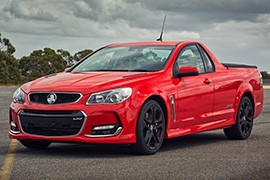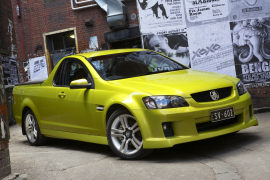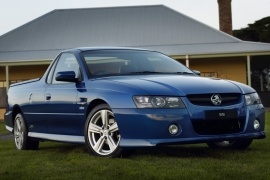HOLDEN Ute Models/Series Timeline, Specifications & Photos
First production year: 2003
Engines: Gasoline, Natural gas
Body style: Truck
The Holden Ute was the most practical muscle-car produced in Australia, and its stance and taxation made it a favorite among the petrolheads from there.
Unfortunately, all good things must come to an end, and the Ute was doomed after GM's decision to shut down the model just a few years later after it introduced the last generation of this outrageous pickup. In 2015, Holden dared to make the vehicle as a farewell to its customers.
The Ute was based on the same platform as the latest VF platform used for the Commodore lineup. It sported a new front fascia with rounded, angled headlights and a big hexagonal "mouth" in the lower bumper area. A pair of side vents provided air to cool the front brakes and enhanced the car's aggressive look. Behind the short, two-door cabin, Holden installed a covered bed good to carry things. But don't think of the Ute as a regular U-haul vehicle.
Inside, the European style dominated the dashboard and its binocular instrument cluster. The infotainment system featured a 7" touch-screen above the center stack, like in Holden's European cousins (Opel and Vauxhall). The aluminum inserts (silver plastic) and the thick steering wheel completed the car's sporty image, while the high-bolstered seats kept its occupants in place during hard cornering.
Under the hood, Holden offered a choice of two engines for the Ute. While the small, 3.6-liter version was for those who didn't want to tear up the tarmac, the 6.2-liter LS3 under the SS version was clearly the one that turned heads on the streets.
Designed as a sports-car dressed as a blue-collar worker, the Ute was Australian's Chevrolet ElCamino and managed to gather a crowd around it.
Holden created the Ute as a regular working vehicle, a pickup for street use with a limited loading area and fuel-efficient engines under the hood. But that was only a part of the truth. It is hard to believe that someone would use a 285 hp pickup vehicle to move its gardening tools around town. In 2013, Holden introduced the VF platform-based Ute and kept it until 2017 when the car left the assembly lines.
The Ute was based on the same platform as the latest Commodore lineup. It sported a new front fascia with rounded, angled headlights and a big hexagonal "mouth" in the lower bumper area. The base versions didn't show any muscles or exaggerated styling, but the front spoiler was not standard for utility vehicles either.
Inside, the European style dominated the dashboard and its binocular instrument cluster. The infotainment system featured a 7" touch-screen above the center stack, like in Holden's European cousins (Opel and Vauxhall). The aluminum inserts (silver plastic) and the thick steering wheel completed the car's sporty image, while the high-bolstered seats kept its occupants in place during hard cornering.
Under the hood, Holden offered a choice of two engines for the Ute. While the small, 3.6-liter version was for those who didn't want to tear up the tarmac, the 6.2-liter LS3 under the SS version was clearly the one that turned heads on the streets.
Holden introduced a new generation of its Ute model in 2007 based on the same platform as the Commodore VE and kept the sport-utility trend going.
For some parts of the world, a pickup with just some bed in the back and a V-6 gasoline engine might be useless. Still, for Australians, that was the kind of vehicle you'd buy if you want a sporty vehicle and enjoy the small taxes for a utility vehicle. And, if the V-6 was not good enough, Holden offered some better options as well.
At the front, it looked the same as the VE Commodore, Calais, or Berlina. Omega's base trim level was mostly for those who used the vehicle for moving refrigerators and AC units around towns, while the top trim levels offered a sporty, aggressive look. All of them shared the same angular headlights but different bumpers. While the Omega featured a wrapped-around plastic bumper with three grilles crossed by a horizontal slat from side to side, the SS-V Redline was a different kind of animal with wide side-scoops, a mesh grille, and a lip-spoiler at the bottom of the apron. But the Omega version could carry heavier loads.
Inside, the carmaker installed a dashboard that looked better in an executive car than in a utility vehicle. Its rounded instrument cluster, the aluminum trims, and tall center console were just a few examples. Holden installed a pair of high-bolstered seats for the two occupants, with a few colors available. The center stack features moldings, displays, and illumination colors that differentiate between the trim levels and variants.
While a 3.0 liter V-6 powered the base model, the top-version featured a 6.0-liter V-8 powerplant that provided 370 hp. For those who really bought the Ute for their utility value, Holden offered a version fueled by LPG.
Registered as a utility vehicle and powered by a Chevrolet LS1 engine, the Holden Ute was an underdog for the sports cars segment.
The Holden Ute was one of the most Australian cars someone could describe. But don't get fooled by its utility look. It wasn't built to move your fridge or your couch from place to place, even though it could easily do that and do it fast. Due to specific country regulations, it was registered as a utility vehicle, but it was a true hot-rod. It was the Australian grand-nephew of the Chevy ElCamino.
From the outside, the VY version shared some parts with the Commodore lineup, especially the headlights. The bumper and the grille were different, even though they fit from one to another. But the Ute was after the A-pillars. It featured a short cabin for two occupants, and then it was cut. The carmaker installed a bed in the back, just in case the owner needs to load something.
Inside, the Ute featured the same dashboard as the VY Commodore, with a wave-like dashboard and a curved instrument cluster. The high-bolstered seats and the tall center console were specific for a sports car. Because that's what it was. It was a sports-car with a bed.
Under the hood, Holden installed a 3.6-liter V-6 engine for the base model. It was a marketing strategy so it could advertise it at a lower price. But most of the vehicles sold were the V-8 versions, with the 315 hp engine. An engine which was rarely left stock.



